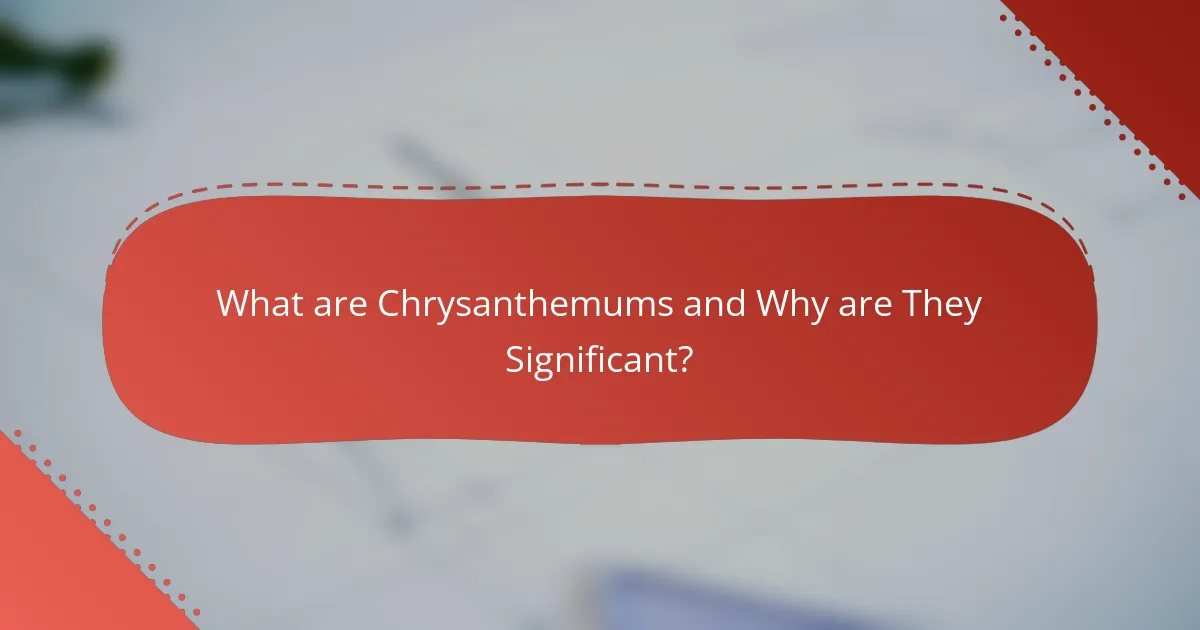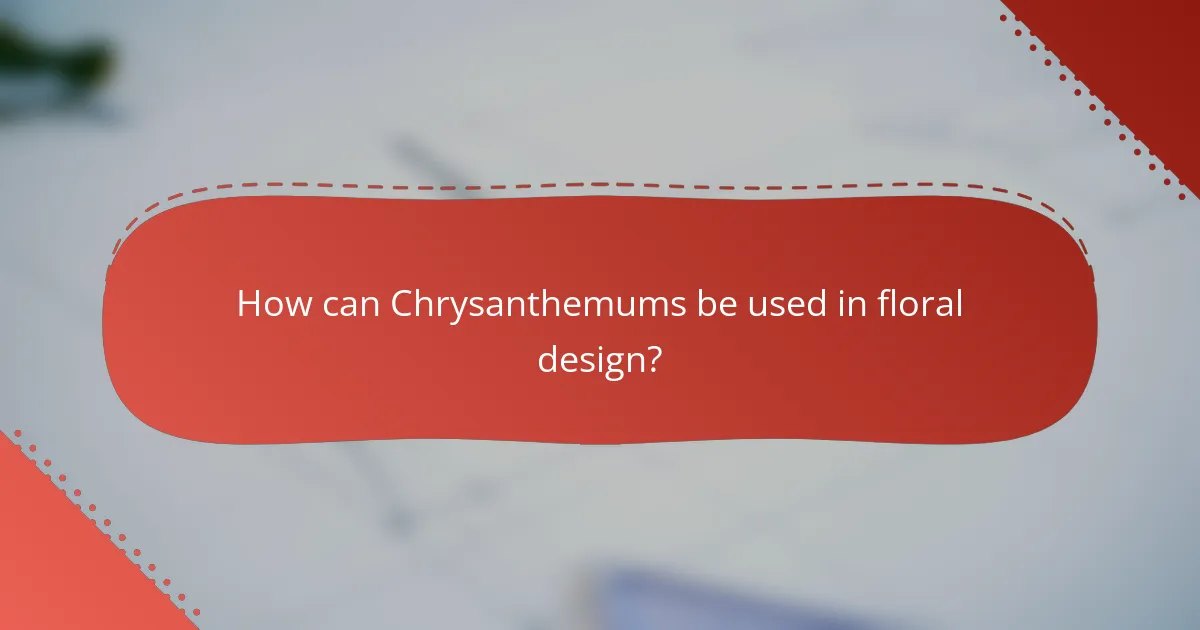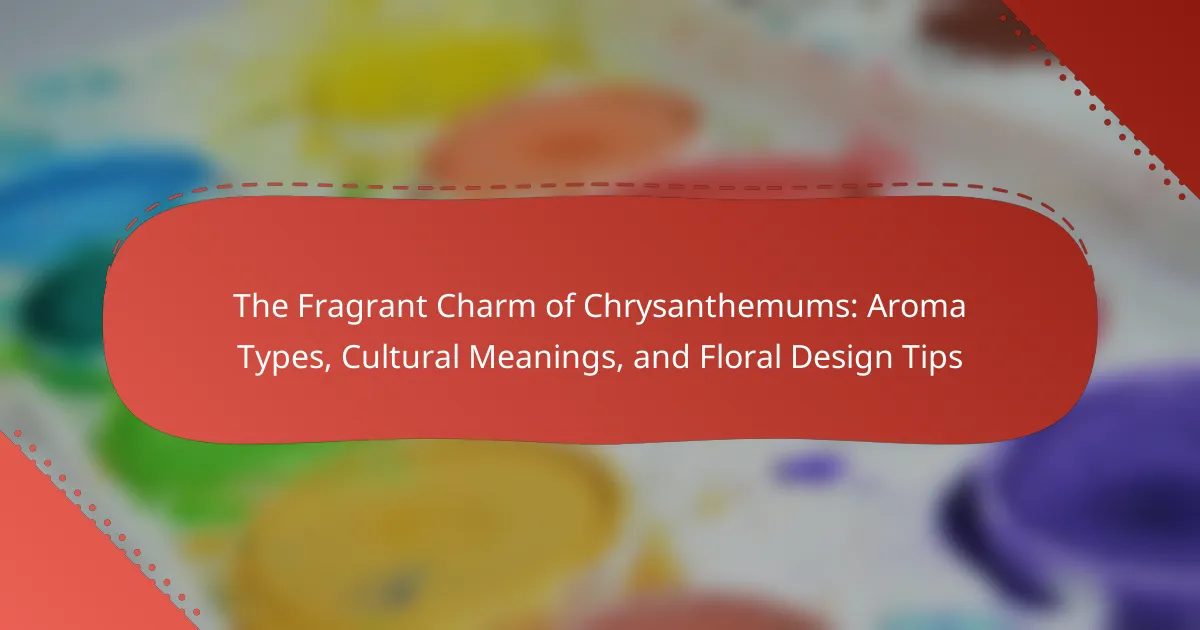
What are Chrysanthemums and Why are They Significant?
Chrysanthemums are flowering plants belonging to the genus Chrysanthemum. They are known for their vibrant colors and various forms. Chrysanthemums are significant for their cultural meanings in different societies. In many cultures, they symbolize joy, optimism, and fidelity. For instance, in Japan, they are celebrated during the Festival of Happiness. Additionally, chrysanthemums are used in traditional medicine for their health benefits. Studies have shown they possess anti-inflammatory and antioxidant properties. This versatility enhances their importance in horticulture and cultural practices worldwide.
How do Chrysanthemums differ from other flowers?
Chrysanthemums differ from other flowers primarily in their unique structure and cultural significance. They possess a distinctive bloom shape, often featuring a dense cluster of petals. This contrasts with many flowers that have a more open or single-petal structure. Additionally, chrysanthemums are known for their diverse color range, including yellow, white, pink, and purple.
Culturally, chrysanthemums hold significant meaning in various societies. In Japan, they symbolize longevity and rejuvenation, while in China, they represent nobility and elegance. This cultural importance sets them apart from many other flowers that may not carry such deep symbolic meanings.
Furthermore, chrysanthemums are primarily grown for ornamental purposes and are often used in floral arrangements, unlike some flowers that are primarily cultivated for their fragrance or edible qualities.
What are the unique characteristics of Chrysanthemums?
Chrysanthemums are unique for their diverse flower forms and colors. They can exhibit single, double, or pompon shapes. The colors range from white, yellow, and pink to deep red and purple. Chrysanthemums are also known for their long-lasting blooms, which can last several weeks. Their foliage is typically dark green and serrated. Additionally, these flowers have a distinct aroma, often described as earthy or spicy. Chrysanthemums are significant in various cultures, symbolizing honor and loyalty in some traditions. They are also commonly used in floral arrangements and gardens for their aesthetic appeal.
How do the growing conditions affect Chrysanthemum characteristics?
Growing conditions significantly influence Chrysanthemum characteristics. Factors such as soil type, water availability, and light exposure affect their growth. Well-drained, nutrient-rich soil promotes healthy root development. Adequate water prevents stress and enhances flower quality. Full sunlight exposure encourages vibrant blooms and robust foliage. Conversely, insufficient light can lead to leggy growth and fewer flowers. Temperature extremes can also impact flowering time and plant vigor. Studies show that optimal growing conditions can increase flower size and color intensity. For instance, research indicates that chrysanthemums grown in ideal conditions exhibit a 30% increase in bloom size compared to those in suboptimal environments.
What are the various aroma types of Chrysanthemums?
Chrysanthemums exhibit several distinct aroma types. Common aroma types include floral, spicy, and herbal scents. Floral aromas are often sweet and reminiscent of other flowers. Spicy aromas can include hints of clove or cinnamon. Herbal scents may evoke fresh green notes. Each aroma type contributes to the overall appeal of chrysanthemums in gardens and floral arrangements. The variety in aroma types enhances their popularity in different cultural contexts.
What are the primary aroma profiles associated with Chrysanthemums?
Chrysanthemums primarily exhibit sweet, floral, and earthy aroma profiles. These flowers often carry a rich, herbal scent that can be both refreshing and calming. Some varieties also present citrus notes, enhancing their fragrance complexity. The aroma can vary significantly among different chrysanthemum cultivars. For instance, some types may have a stronger spicy undertone, while others lean towards a more subtle, delicate scent. This aromatic diversity contributes to their popularity in floral arrangements and gardens. Additionally, studies have shown that the essential oils extracted from chrysanthemums contain compounds responsible for these distinctive aromas.
How do different Chrysanthemum varieties influence aroma types?
Different Chrysanthemum varieties produce distinct aroma types. Each variety has unique compounds that contribute to its scent profile. For example, the ‘Pompon’ variety is known for its sweet, fruity aroma. In contrast, ‘Spider’ chrysanthemums often emit a more herbal scent. Research indicates that these differences arise from variations in essential oil composition. Specific compounds like pyrazines and terpenes influence the fragrance of each variety. Studies have shown that environmental factors also play a role in aroma development. Ultimately, the interaction between genetics and environment shapes the aromatic characteristics of Chrysanthemum varieties.
What cultural meanings are associated with Chrysanthemums?
Chrysanthemums symbolize different cultural meanings across various societies. In Japan, they represent honor and nobility. They are celebrated during the Festival of Happiness. In Chinese culture, chrysanthemums signify longevity and vitality. They are associated with the concept of reclusion and are often depicted in art. In Europe, they are seen as a symbol of friendship and positivity. In some contexts, they are also associated with mourning and remembrance. This duality highlights their complex role in cultural symbolism.
How do different cultures perceive Chrysanthemums?
Chrysanthemums are perceived differently across various cultures. In Japan, they symbolize nobility and are celebrated during the Festival of Happiness. They are also associated with longevity and are featured in royal insignia. In China, chrysanthemums represent autumn and are linked to resilience. They are often used in traditional medicine for their health benefits. In Western cultures, chrysanthemums are commonly associated with death and are used in funerals. This stems from their association with mourning in countries like the United States and France. Each cultural perception highlights the diverse meanings attributed to chrysanthemums globally.
What historical significance do Chrysanthemums hold in various traditions?
Chrysanthemums hold significant historical importance in various cultures. In Japan, they symbolize nobility and are celebrated during the Chrysanthemum Festival, known as “Kiku Matsuri.” This festival dates back to the 8th century and honors the flower’s beauty and resilience. In Chinese culture, chrysanthemums represent longevity and are one of the “Four Gentlemen” of flowers, symbolizing virtue and perseverance. They are also featured in traditional Chinese paintings and poetry. In Western traditions, chrysanthemums are often associated with death and are used in funerals, symbolizing remembrance. Thus, the historical significance of chrysanthemums varies widely across cultures, reflecting diverse values and beliefs.

How can Chrysanthemums be used in floral design?
Chrysanthemums can be used in floral design as focal flowers or filler blooms. Their diverse shapes and colors enhance visual interest. They are versatile and can be arranged in bouquets, centerpieces, or wreaths. Chrysanthemums have a long vase life, making them practical for various occasions. In addition, they symbolize optimism and joy, adding emotional significance to arrangements. Their seasonal availability also allows for creative designs year-round. Many floral designers incorporate them to create texture and depth in arrangements. Overall, chrysanthemums are a popular choice in both traditional and contemporary floral design.
What are the best practices for arranging Chrysanthemums?
The best practices for arranging Chrysanthemums include selecting a variety of colors and sizes for visual interest. Use a clean, sharp knife to cut stems at an angle. This increases water uptake and prolongs freshness. Remove lower leaves to prevent rot in the water. Arrange taller flowers in the center for height, and shorter ones around the edges for balance. Use a clean vase filled with fresh water and floral preservative. Change the water every few days to maintain vitality. These practices ensure a vibrant and long-lasting floral display.
What tips can enhance the visual appeal of Chrysanthemum arrangements?
Use a variety of colors to create contrast in Chrysanthemum arrangements. Mixing different hues enhances visual interest. Incorporate varying flower sizes for depth and dimension. This creates a more dynamic display. Utilize greenery to complement the blooms. Foliage adds texture and richness to the arrangement. Choose an attractive vase that matches the theme. The right container can elevate the overall look. Arrange flowers in clusters for a fuller appearance. Grouping creates a more cohesive and impactful presentation. Lastly, vary the height of the flowers. This adds layers and enhances the aesthetic appeal.
How can Chrysanthemums be combined with other flowers in arrangements?
Chrysanthemums can be combined with other flowers in arrangements by pairing them with blooms that complement their colors and textures. For instance, they work well with roses due to their similar petal structure. Additionally, mixing chrysanthemums with greenery like ferns enhances their vibrant appearance. Using contrasting flowers, such as sunflowers, can create a dynamic visual effect. Seasonal flowers, like tulips, can also be combined for a fresh look. These combinations can vary based on the occasion and desired aesthetic. The versatility of chrysanthemums allows them to fit into various floral designs, from casual bouquets to formal centerpieces.
What occasions are ideal for using Chrysanthemums in floral design?
Chrysanthemums are ideal for various occasions in floral design. They are commonly used for fall celebrations, including harvest festivals and Thanksgiving. Their vibrant colors reflect the autumn season, making them a popular choice for seasonal arrangements. Chrysanthemums are also significant in cultural celebrations, such as the Japanese festival, Kiku Matsuri, which honors the flower’s beauty. Additionally, they are often used in sympathy arrangements due to their association with remembrance. Their longevity in arrangements makes them suitable for weddings and anniversaries as well. Overall, chrysanthemums offer versatility for both festive and solemn occasions.
Which events benefit from the inclusion of Chrysanthemums?
Chrysanthemums are beneficial for various events such as weddings, funerals, and festivals. In weddings, they symbolize love and fidelity, enhancing floral arrangements. For funerals, chrysanthemums represent honor and respect, often used in memorial displays. Festivals, particularly in Asia, celebrate chrysanthemums as symbols of joy and longevity. Their vibrant colors and diverse forms make them versatile for any occasion. These attributes contribute to their popularity in floral design across cultures.
How do seasonal variations affect the use of Chrysanthemums in design?
Seasonal variations significantly influence the use of Chrysanthemums in design. In spring, Chrysanthemums are often used for fresh, vibrant arrangements. They symbolize renewal and growth, aligning with the season’s themes. During summer, these flowers can complement outdoor events, adding color to gardens and patios. In fall, Chrysanthemums are particularly popular for autumn displays and festivals. Their rich hues reflect the seasonal palette, enhancing festive decorations. Winter arrangements may utilize dried or preserved Chrysanthemums, as fresh blooms are less available. This adaptability across seasons makes them a versatile choice in floral design.

What practical tips should be considered when working with Chrysanthemums?
Chrysanthemums thrive in well-drained soil and require full sunlight for optimal growth. Watering should be consistent, ensuring the soil remains moist but not soggy. Fertilize chrysanthemums with a balanced fertilizer during the growing season to promote flowering. Pruning spent blooms encourages new growth and extends the blooming period. Pests such as aphids and spider mites can affect chrysanthemums; regular inspection and treatment are necessary. Additionally, consider planting them in groups for a more vibrant display. Proper spacing between plants allows for air circulation, reducing disease risk. Lastly, chrysanthemums are sensitive to frost; cover them if frost is expected.
How can one care for Chrysanthemums to ensure longevity?
To care for Chrysanthemums and ensure longevity, provide them with adequate sunlight. Chrysanthemums thrive in full sun, requiring at least six hours of direct light daily. Water them consistently, keeping the soil moist but not soggy. Overwatering can lead to root rot, which shortens their lifespan. Fertilize them every four to six weeks during the growing season with a balanced fertilizer. This supports healthy growth and blooming. Pinch back the tips of the plants in early summer to promote bushier growth. Regularly remove dead or wilted flowers to encourage new blooms. Finally, protect them from frost by covering them or bringing potted plants indoors when temperatures drop.
What are the common issues faced when caring for Chrysanthemums?
Common issues faced when caring for Chrysanthemums include pests, diseases, and environmental stress. Pests such as aphids and spider mites can damage the plants. Diseases like root rot and powdery mildew affect their health. Environmental stress arises from inadequate sunlight or improper watering. Overwatering can lead to root rot, while underwatering causes wilting. Additionally, poor soil quality can hinder growth. These factors collectively impact the vitality of Chrysanthemums.
How can one effectively propagate Chrysanthemums?
To effectively propagate chrysanthemums, one can use methods such as stem cuttings or division. Stem cuttings should be taken from healthy plants during the growing season. Cut a 4 to 6-inch section from the tip of a stem. Remove the lower leaves and place the cutting in moist potting soil. Keep the soil consistently damp and provide indirect sunlight. Rooting hormone can enhance success rates.
For division, dig up established plants in the spring or fall. Carefully separate the root clumps into sections, ensuring each has roots and shoots. Replant the divisions immediately in well-drained soil. Both methods can yield new plants that maintain the characteristics of the parent plant.
What are some creative ways to incorporate Chrysanthemums into decor?
Chrysanthemums can be creatively incorporated into decor by using them in various arrangements and settings. They can be placed in vases as centerpieces for tables. This enhances the aesthetic appeal of dining areas. Another option is to use them in wreaths for door decorations. Chrysanthemums add a seasonal touch to entryways. Additionally, they can be used in floral garlands to adorn mantels or staircases. This creates a vibrant atmosphere in living spaces. Incorporating them into hanging planters also provides a unique visual element. Lastly, using Chrysanthemums in themed arrangements for events can elevate the overall decor. Their diverse colors and shapes make them versatile for various styles.
How can Chrysanthemums enhance home interior design?
Chrysanthemums enhance home interior design by adding vibrant colors and textures. They come in various hues, such as yellow, red, and white. These colors can complement different interior styles. Chrysanthemums also provide a natural element, improving the overall ambiance. Their presence can create a welcoming atmosphere in living spaces. Additionally, they have a long blooming period, offering lasting beauty. Studies show that indoor plants, including chrysanthemums, can improve air quality. This makes them not only decorative but also beneficial for health.
What DIY projects can feature Chrysanthemums for personal touch?
Chrysanthemums can be used in various DIY projects for a personal touch. One popular project is creating floral arrangements. These arrangements can be tailored to match any decor style. Another option is making wreaths using dried or fresh chrysanthemums. This adds a seasonal touch to home decor. Chrysanthemums can also be incorporated into homemade potpourri. This enhances the fragrance of a room. Additionally, they can be used in pressed flower art. This creates unique wall decorations. Lastly, chrysanthemum-infused oils or soaps can be made for personal use or gifts. These projects allow for creativity and personalization with chrysanthemums.
Chrysanthemums are flowering plants known for their vibrant colors, diverse forms, and significant cultural meanings across various societies. This article explores the unique characteristics of chrysanthemums, including their aroma types and the influence of growing conditions on their attributes. It also examines the cultural symbolism associated with chrysanthemums in different regions, their historical significance, and practical tips for incorporating them into floral design. Additionally, the article provides insights into the best practices for caring for chrysanthemums and creative ways to utilize them in home decor.
